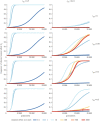The effectiveness of pseudomagic traits in promoting premating isolation
- PMID: 36883275
- PMCID: PMC9993058
- DOI: 10.1098/rspb.2022.2108
The effectiveness of pseudomagic traits in promoting premating isolation
Abstract
Upon the secondary contact of populations, speciation with gene flow is greatly facilitated when the same pleiotropic loci are both subject to divergent ecological selection and induce non-random mating, leading to loci with this fortuitous combination of functions being referred to as 'magic trait' loci. We use a population genetics model to examine whether 'pseudomagic trait' complexes, composed of physically linked loci fulfilling these two functions, are as efficient in promoting premating isolation as magic traits. We specifically measure the evolution of choosiness, which controls the strength of assortative mating. We show that, surprisingly, pseudomagic trait complexes, and to a lesser extent also physically unlinked loci, can lead to the evolution of considerably stronger assortative mating preferences than do magic traits, provided polymorphism at the involved loci is maintained. This is because assortative mating preferences are generally favoured when there is a risk of producing maladapted recombinants, as occurs with non-magic trait complexes but not with magic traits (since pleiotropy precludes recombination). Contrary to current belief, magic traits may not be the most effective genetic architecture for promoting strong premating isolation. Therefore, distinguishing between magic traits and pseudomagic trait complexes is important when inferring their role in premating isolation. This calls for further fine-scale genomic research on speciation genes.
Keywords: mate choice; mathematical model; recombination; secondary contact; speciation; third-order linkage disequilibrium.
Conflict of interest statement
We declare we have no competing interests.
Figures




Similar articles
-
The effectiveness of pseudomagic traits in promoting divergence and enhancing local adaptation.Evolution. 2020 Nov;74(11):2438-2450. doi: 10.1111/evo.14056. Epub 2020 Aug 14. Evolution. 2020. PMID: 32652577
-
Does divergent selection predict the evolution of mate preference and reproductive isolation in the tropical butterfly genus Melinaea (Nymphalidae: Ithomiini)?J Anim Ecol. 2019 Jun;88(6):940-952. doi: 10.1111/1365-2656.12975. Epub 2019 Apr 8. J Anim Ecol. 2019. PMID: 30873614
-
Evolution of physical linkage between loci controlling ecological traits and mating preferences.J Evol Biol. 2022 Nov;35(11):1537-1547. doi: 10.1111/jeb.14105. Epub 2022 Oct 5. J Evol Biol. 2022. PMID: 36196988 Free PMC article.
-
Magic traits in speciation: 'magic' but not rare?Trends Ecol Evol. 2011 Aug;26(8):389-97. doi: 10.1016/j.tree.2011.04.005. Epub 2011 May 17. Trends Ecol Evol. 2011. PMID: 21592615 Review.
-
Introgression of wing pattern alleles and speciation via homoploid hybridization in Heliconius butterflies: a review of evidence from the genome.Proc Biol Sci. 2012 Dec 12;280(1752):20122302. doi: 10.1098/rspb.2012.2302. Print 2013 Feb 7. Proc Biol Sci. 2012. PMID: 23235702 Free PMC article. Review.
References
-
- Coyne JA, Orr HA. 2004. Speciation. Sunderland, MA: Sinauer Associates.
Publication types
MeSH terms
Associated data
LinkOut - more resources
Full Text Sources

